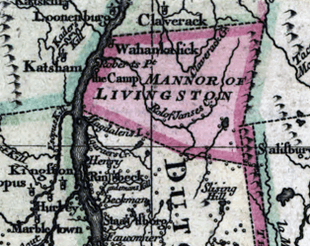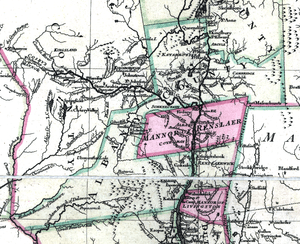Livingston Manor
Livingston Manor was a 160,000 acre (650 square kilometres (250 sq mi)) tract of land granted, in present-day New York and New Jersey, to Robert Livingston the Elder during the reign of George I of Great Britain.
- This article contains information related to Livingston Manor, the 18th century New York estate. Livingston Manor, New York, is a hamlet in Sullivan County. The Livingston Manor Historic District is located in Highland Park, New Jersey.
History


Livingston Manor was a 160,000 acre (650 square kilometres (250 sq mi)) tract of land granted to Robert Livingston the Elder through the influence of 5th Governor Thomas Dongan, and confirmed by royal charter of George I of Great Britain in 1715, creating the manor and lordship of Livingston.[1] The original patent was obtained in July 1686.[2] This tract embraced a large portion of what is now Columbia County. The lords of the manor were:
- Robert Livingston the Elder (1654–1728), served from 1715–1728.
- Philip Livingston (1686–1749), served from 1728–1749.
- Robert Livingston (1708–1790), served from 1749–1790.
Although an English-deeded tract, some sources list Livingston Manor with the patroonships of New Netherland.
Division of land
The first division of the estate occurred in 1728 upon the death of Robert Livingston the Elder, who stipulated that his third son, Robert Livingston (1718–1775), be granted 13,000 acres (53 square kilometres (20 sq mi)) from Livingston Manor's southwest corner, a tract which Robert christened Clermont Manor.
In 1790, upon the death of the last lord of the manor, Robert Livingston, the remainder of Livingston Manor was divided among his heirs, rather than continue to pass down through primogeniture, as Robert disapproved of his eldest son, who had made many unwise financial decisions and was perennially in debt.[2] The inheritors of the estate were all men who had distinguished themselves considerably during and after the American Revolution:
- Philip Livingston (1716–1778), delegate to the Continental Congress and signatory of the United States Declaration of Independence
- William Livingston (1723–1790), 1st Governor of New Jersey and signatory of the United States Constitution
- William Alexander (1726–1783), major general in the Continental Army during the American Revolutionary War
- James Duane (1733–1797), delegate to the Continental Congress, 44th Mayor of New York City, and signatory of the Articles of Confederation
These four heirs subsequently divided the land among their own families, and the power of the Livingston family was slowly diminished. A portion of the estate is still held by the family. The town of Livingston, New York occupies part of the original tract.
Present day
The original Livingston Manor encompasses the present day towns of Livingston, Germantown, Clermont, Taghkanic, Gallatin, Copake, and Ancram, located in Columbia County New York.[2]
Other Livingston Manors
Livingston Manor, New York
Livingston Manor, in present-day Sullivan County in New York State, capitalizes on the Livingston Manor name because Manor family members and descendants had a house there however it was not part of the original manor
The Sullivan County community, which is about 60 miles (97 km) west of the original manor, was part of the Hardenbergh patent in 1716 which included much of the Catskill Mountains.
In 1750, Robert Livingston, the third lord, bought 95,000 acres (380 km2) in the area shortly after becoming the third (and final) Lord of the Manor of Livingston Manor. Most of the land would be sold or leased by 1780. Robert's third son John Robert Livingston (1775–1851)[3] deeded 8,441 acres (34.16 km2) to his nephew Dr. Edward R. Livingston in 1822 around area then called Purvis, New York.
In 1882, Purvis was renamed Livingston Manor.[4] Edward's "manor," which was actually just a house, was on the site of the present village firehouse, according to a modern sign in the village,[5] however other speculation says the house was on the location of the village Town Hall.[6]
Livingston Manor, New Jersey
The Reverend John Henry Livingston, a member of the Livingston family, was chosen head of Queen's College (now Rutgers University) and in 1809 purchased a 150-acre (0.61 km2) plot of land nearby Raritan Landing, which would thereafter be known as the Livingston Manor. A Greek Revival mansion built by descendants Robert and Louisa Livingston around 1843 stands on the property and is now known as Livingston Homestead. At the turn of the 20th century, the property was developed as a streetcar suburb, and in 2004 became part of the Livingston Manor Historic District.[7][8] The house and the district are listed on the New Jersey Register of Historic Places and the National Register of Historic Places.[9][10]
See also
References
| Wikimedia Commons has media related to Livingston Manor. |
- Notes
- Livingston, Edwin Brockholst (1910). The Livingstons of Livingston manor; being the history of that branch of the Scottish house of Callendar which settled in the English province of New York during the reign of Charles the Second; and also including an account of Robert Livingston of Albany, "The nephew," a settler in the same province and his principal descendants. New York: The Knickerbocker Press. Retrieved 16 September 2016.
- Livingston, James D.; Penney, Sherry H. (March 1987). "The Breakup of Livingston Manor" (PDF). The Hudson Valley Regional Review. Vol. 4, Number 1: 56–73. Retrieved 16 September 2016.
- Ulster.net Archived 2007-10-13 at the Wayback Machine
- LivingstonManor.net
- LivingstoneManor.net
- LivingstoneManor.net
- Spies, Stacy. National Register nomination for Livingston Homestead (Washington, DC, National Park Service, 2001).
- "Livingston Manor Historic District". Highland Park Historical Society. Archived from the original on 2011-06-06. Retrieved 2011-07-06.
- "New Jersey and National Registers of Historic Places – Middlesex County" (PDF). NJ DEP – Historic Preservation Office. June 2, 2011. p. 11. Archived from the original (PDF) on June 4, 2011. Retrieved July 5, 2011.
- "New Jersey – Middlesex County". National Register of Historic Places. Retrieved 2011-07-05.
- Sources
- Raken.com, Manor Lords
- CooperativeIndividualism.org, Dutch Patroons